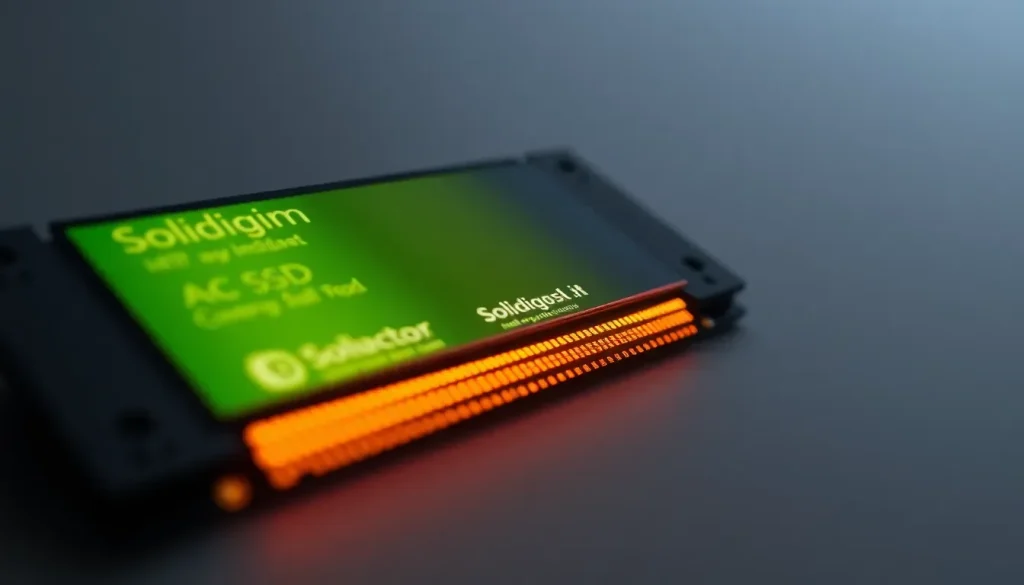Solidigm reveals insights into SSD roadmap

The world of solid-state drives (SSDs) is rapidly evolving, particularly as companies delve into ultra-high-capacity storage solutions. In this landscape, Solidigm, a key player in the SSD market, is redefining its approach and capabilities. Their latest advancements and strategies are crucial for businesses looking to optimize their data storage solutions and stay competitive in an increasingly data-driven environment.
Solidigm's Innovative Drive Technology
Solidigm has established itself as a pioneer in the realm of high-capacity SSDs, introducing groundbreaking products such as the 61.44 TB QLC drive in July 2023 and the 122 TB drive in November 2024. Both of these drives utilize 192-layer QLC 3D NAND technology, a significant leap in storage capacity that was first introduced in mid-2022.
However, the competitive landscape is shifting, with other manufacturers like SK hynix leading the charge with advancements such as their 321-layer 3D NAND. This rapid development raises pertinent questions about Solidigm's position and future direction:
- What will be Solidigm's role within the larger SK hynix organization?
- Is Solidigm planning to develop SSDs with layer counts exceeding 200 or even 300 layers?
- Will the company adopt SK hynix's NAND technology or maintain its own development path?
- What is the potential future for PLC flash technology?
- How will Solidigm navigate geopolitical challenges affecting its manufacturing operations in Dalian, China?
Insights from Solidigm Leadership
In a recent discussion with Roger Corell, Solidigm’s Senior Director of AI and Leadership Marketing, the company emphasized its strategic focus on leveraging AI to enhance business growth. Corell stated, “We are undergoing an AI-fueled business momentum phase,” underscoring the increasing significance of storage solutions in AI infrastructure.
He elaborated on the critical nature of optimizing every resource in data centers, where “every watt and every square inch counts.” As businesses transition into an era of exabyte-scale storage needs, ensuring that storage does not become a bottleneck is paramount. This ongoing evolution signifies that storage is becoming a fundamental component in the discourse surrounding AI infrastructure.
Technological Advancements and Future Directions
Solidigm is not merely focused on layer count; they are also innovating in other crucial aspects. Corell pointed out that while their current offerings stand at 192 layers, they are actively working to surpass the 200-layer mark with their next-generation SSDs. He emphasized that various factors contribute to SSD performance, including:
- Layer count
- Bits per cell
- Cell size and density
This multifaceted approach to SSD design enables Solidigm to deliver advanced storage solutions that meet the evolving demands of the market.
Challenges and Opportunities in the SSD Market
Despite its innovation, Solidigm faces challenges in an industry that is moving quickly. With competitors like SK hynix leading with higher layer counts, Solidigm must adapt its strategy. Corell mentioned that Solidigm is confident in its technology and plans to be the first to market with a 245 TB SSD by the end of 2026, which will utilize a new design that exceeds the current layer count.
The manufacturing process for these new drives will take place at Solidigm's facilities in Dalian, China, which presents potential complications due to U.S. tariffs and geopolitical considerations. Corell expressed optimism about navigating these challenges while maintaining Solidigm's technological independence.
Future of QLC and PLC Technology
As Solidigm continues to innovate, the conversation around QLC (Quad-Level Cell) and the potential for PLC (Penta-Level Cell) technology becomes increasingly relevant. Corell noted that while they have demonstrated working PLC SSDs, it may take time for this technology to become mainstream in the market. He believes that PLC still has a future within Solidigm's portfolio, but its timing remains uncertain.
For the moment, Solidigm remains committed to QLC technology, which has already proven to be a challenge for many manufacturers. Corell highlighted their extensive experience in this area, having shipped over 120 exabytes of QLC technology since they began production in 2018, establishing Solidigm as a leader in high-capacity storage solutions.
Market Position and Competitive Landscape
Solidigm's competitive stance is fortified by its product offerings in both direct-attached storage (DAS) and network-attached storage (NAS). The company currently offers robust solutions that cater to the needs of various sectors, including the fastest-growing neo-clouds and hyperscalers.
Corell also pointed out Solidigm's validation by being included on the Nvidia RVL list, which highlights their commitment to delivering high-performance storage solutions that meet the stringent requirements of AI workloads.
As the demand for efficient and scalable storage solutions grows, Solidigm aims to solidify its position as a leading provider of enterprise SSDs. Their ongoing developments and strategic initiatives will be pivotal in determining their success in this rapidly changing landscape.
For a deeper understanding of the SSD landscape and Solidigm's innovative approach, consider watching the following video, which showcases the latest advancements in SSD technology:
Conclusion: Charting a Course for the Future
Solidigm's trajectory in the SSD market is marked by innovation, strategic foresight, and a commitment to meeting the challenges of an evolving technological landscape. With plans to expand their product offerings and navigate complexities in manufacturing, Solidigm is poised to play a significant role in shaping the future of data storage.
As the industry continues to advance towards higher capacity and more efficient storage solutions, the importance of Solidigm's contributions will only grow. Their focus on optimizing storage for AI and other critical applications underscores their relevance in an increasingly competitive market.



Leave a Reply